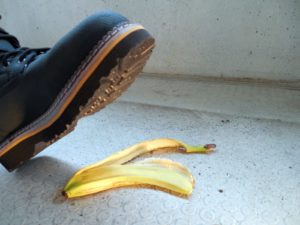
Prevent a Fall
- Sweep the floor. Remove tripping hazards by picking up toys, clothes and debris before bed. Those middle-of-the-night bathroom trips can be treacherous. Look for exposed nails in floorboards. Use rubber-backed rugs. Tuck or tie electrical cords out of walkways.
- Light it up. Dark or dim conditions raise the risk of falls. Invest in inexpensive recessed or track lighting. Pick up a couple of convenient nightlights for halls and bathrooms. Motion sensors can help you save on energy.
- Get a grip. Older people, in particular, could use a little help sometimes getting to their feet. Bathrooms are prime spots for bad falls, so install grab bars in showers and bathtubs and near toilets.
- Case the joint. Regularly inspect home and workplace for tripping hazards. Keep walkways clear of snow, ice and weeds. Mop after business hours or post caution signs.
- Clear the way. Stairways are also risk-prone areas at home and in the workplace. Ensure steps are even and secure. Install slip-resistant carpeting. Never store shoes, toys or other belongings on steps.
- Keep it moving. A sedentary lifestyle can be a risk factor for falling. By engaging in regular physical activity—even gentle activities like walking, water workouts or tai chi—you reduce your risk by increasing mobility, flexibility and balance.
- Check it up. Ask your doctor to review your current medications for any that could raise your risk of falling. Discuss any past falls. Get your vision checked and your eyewear updated as needed.
In Case of Fall
If falls occur, and the seriousness of injury is in doubt, call 911. Keep the fallen person warm and comfortable. Stay calm and encourage them to take slow, deep breaths. If they feel confident enough to get up, gently assist them but don’t attempt to carry their full weight.
According to the Centers for Disease Control and Prevention (CDC), one out of every four elderly people fall every year, but fewer than half tell their doctor. Be sure to let your doctor know if you’ve fallen, as steps might be available to prevent future falls, such as changes in medication.
Protect Yourself from a Lawsuit
If a person falls on your property, the laws of negligence apply. Property owners have a responsibility to keep their premises in reasonably safe condition, clear of defects and hazards. Failure to do so could leave you open to a lawsuit.
You can’t always prevent a fall, so make sure you have good homeowner’s insurance—and liability insurance as a business owner—in place. If you have questions about how to protect yourself with coverage, give us a call. We’re experts and can steer you to the best policies available.
